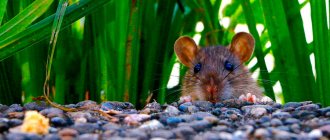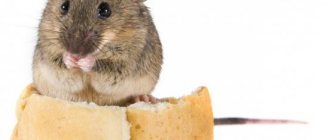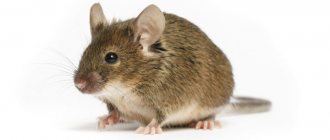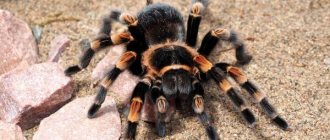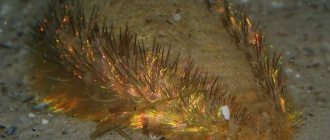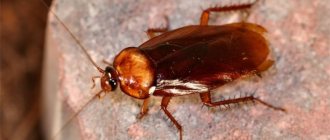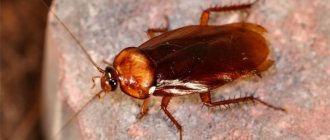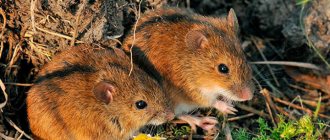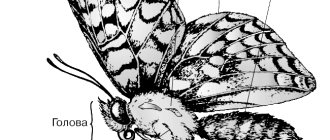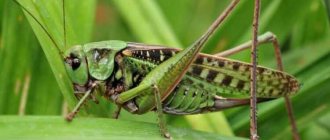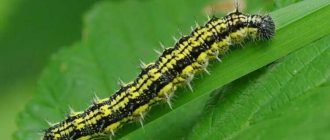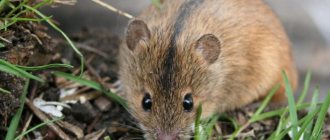Scientists have been able to identify a lot of different rodents; they live in different parts of the planet. They are not found only on the coldest continents, but on the rest they live.
Among them, people's favorites are hamsters, since they are often found at home, although they live freely in nature, as well as rats, which are also often pets or live in people's houses without their permission, voles and ordinary mice.
The latter are especially disliked by people, since they often destroy winter supplies and are considered dangerous carriers of diseases.
Usually people have difficulty distinguishing rodents and cannot always tell exactly who is in front of them. But this is not surprising in the case of mice, since among them there are approximately 400 different species.
Outwardly, they are all very similar, and behave almost identically. The animal mouse is famous for its incredible cunning and is difficult to catch. People have been fighting for centuries, primarily with this representative of rodents.
What are the external features of the mouse?
Nowadays, many photos of mice are taken, and they are easy to find on the Internet. Due to this, it is possible to accurately determine what species a mouse that appears on human territory belongs to.
Usually its body does not exceed 10 cm, moreover, about half the size is the tail. This small process is always bare, and it is difficult to detect the presence of hairs on it. At the same time, the body is completely covered with hair of a uniform color.
However, there are two unique species that have spines that replace fur. We are talking about Elliott the mouse and the so-called spiny species. The fur of these strange creatures is replaced by needles similar to thorns, like those of a cactus.Mice are brown, sometimes brown, and gray ones are common. Scientists have discovered mice that have stripes running down their backs.
Mouse squad
Mice are classified as mammals because they give birth to live young. After birth, the female feeds her offspring with milk for a month. Each female has 8 nipples. After mating, the female carries the future mice for about 25 days. 9 days after giving birth, she can mate again and again bring forth offspring. Each time she can give birth to from 1 to 12 cubs. She can become pregnant up to 5 times in a year. The rodent population increases noticeably once every 7 years.
Newly born mice have no fur, no teeth, and they cannot see yet. After just 1 week, the offspring have teeth and hair begins to grow, and after another 20 days they can feed on their own. After 3 months, the young offspring are able to fertilize themselves, increasing the rodent population.
How are mice different from other rodents?
If we conduct a detailed description of mice, it is important to note that they have excellent hearing, allowing them to pick up sounds of various tones. To do this, they use ears that are rounded in shape.
On the small pointed muzzle you can notice the presence of antennae called vibrissae. Thanks to this important organ, mice are able to navigate perfectly, even in the dark. However, they do not have pouches behind their cheeks.
Most species of mice do not like to climb trees, however, they easily move on the basis of grass stems growing in meadows. And also for this they use reeds or small branches of bushes.Among them, the smallest individual was identified; it was named “baby”, since it has a body size of only 5 cm.
Take care of the cage
- It is better to buy a large enclosure with 2-3 floors.
- It’s good if there are stairs in it - animals like to move by jumping. They will be happy to play with a small wheel and a tube.
- Mice love the process of bathing - setting up a small pool will greatly please them.
- It is permissible to use a transparent plastic box or an aquarium as a house.
Where do different types of mice live?
Due to the characteristics of the body, this animal was able to take root in any place. In most cases, they use the surface of the earth to live, however, some species have good skills in moving along vertical surfaces.
Where do mice live and how can humans meet them? Usually, people most often encounter two types of these rodents, since only the Cairo or house mouse lives near human buildings.
Some mice like to live near various bodies of water, and they swim tolerably well. They do not like to have couples and usually live alone.- Detailed description with photos of all animals included in the Red Book of Russia
- Zebra - habitats, appearance, diet and behavior, life cycle + 94 photos
Leopard - habitats, life cycle, rutting season and lifespan + 118 photos
However, a subspecies of the house mouse, called the Kurganchik mouse, likes to start a family of up to 20 individuals living in a common burrow. They create common reserves for wintering and build nests necessary for life.
Most mice like to live in a permanent place. They leave their inhabited area only if necessary due to some environmental changes. However, they usually do not move far, since they do not have the desire to look for a long time for a new place to live.
Lifestyle
A mouse can cause enormous damage to humans. By nature and food preferences, a rodent is a predator. But the pest mainly consumes plant foods and therefore its diet consists of seeds, fruits of trees or shrubs and cereal crops. Mice living in swampy areas, wet or flooded meadows feed on the buds, foliage or flowers of various plants.
Habitat of a mouse A herbivorous creature with an appetite eats helpless chicks, drags eggs from nests, feasts on worms and various insects, replenishing the body's protein reserves. When settling in or near a person’s home, mice happily destroy potatoes, sausages and bakery products, eggs and other food products that are easy to get to. They do not disdain soap, candles, toilet paper, books, and polyethylene.
Interesting!
The strong smell of cheese can repel rodents.
Various breeds of mice, having settled almost throughout the planet, arranging their habitat, can build nests from grass stems, occupy abandoned holes, old hollows, or dig complex underground systems with many passages. Once in a person’s home, rodents settle under the floor, in attics, and between walls. Unlike representatives living in swamps and near water bodies, steppe, mountain and forest mice swim poorly.
The active life of animals coincides with the evening or night time, but they try not to move too far from their home. The mouse has many enemies, these include birds of prey, reptiles, mongooses, foxes, hedgehogs, cats, crows and other representatives of the fauna.
Important!
Mice make huge reserves for the winter, but do not hibernate.
Mostly voracious and ubiquitous rodents cause harm, but there is one area of science in which the omnivorous mouse is useful and irreplaceable. These are special scientific and medical laboratories where animals become experimental subjects. Thanks to these small animals, many important discoveries were made in genetics, pharmacology, physiology and other sciences. Surprisingly, 80% of the genes endowed with a living mouse are similar to human structures.
Nutrition
Typically, these animals, which live in their natural environment, feed on grains, grain stalks, and seeds. They like any plant food - tree fruits, grass seeds and everything that can be obtained from a plant. If this rodent lives near human habitation, then its menu is much more varied.
Here bread, vegetables, and sausage are already eaten - the mouse is not capricious in its choice. It also happens that mice eat their weaker brothers, but this happens if the mice are locked together in a cage and there is nowhere else to get food. Rats do the same.
If you manage to buy a mouse as a pet, then you can feed it with cereals, bread, cheese, vegetables, as well as any plant food, but it is better to stick to a diet that is close to the natural diet of these animals. You should feed your pet once a day; overfeeding these babies can lead to diseases.
Character and lifestyle
Since mice live in areas with different climates, they need to adapt to different living conditions, and mice have not one, but several ways of adaptation:
- Active throughout the year. These animals make provisions for a rainy day all year round.
- But they can do without supplies if their place of residence is shops, residential buildings or food warehouses;
- Seasonal migrations - closer to winter, mice migrate from their natural habitat to places that are located near human habitation, and in the spring they move back;
- In order to maintain optimal body temperature in hot or cold seasons, the mouse must move too much, and for this it absorbs a lot of food.
The entire life cycle of this rodent depends on body temperature. If a mouse does not move in winter, it will freeze, and if it does not move in summer, during the hot period of the year, then the body will produce excess heat, which can kill the animal.
Therefore, the entire life activity of a mouse consists of the fact that it moves - it gets food for itself, eats, engages in mating games and raises offspring. The main movement in mice begins with the onset of darkness. It is then that they begin to look for food, set up their home, that is, they dig holes, and protect their area from their fellow tribesmen.
Do not think that a tiny mouse is a cowardly creature. In the process of protecting her home, she can attack an animal that is much larger than the mouse itself. If a mouse lives in a place where there is constant twilight, then it is more active, and it has to rest less and in periods.
But if there are people constantly in the habitat of mice, then the mice are not too “shy” - when the room is quiet, they can go out in search of food during the daytime. However, if a mouse is kept as a pet, then it has to adapt to the owner's regime. These animals live in groups, because a single individual will not be able to make large enough reserves, find food and detect danger in time.
True, life in a mouse family is not always cloudless - serious conflicts also occur, which, as a rule, break out due to lack of food. Females are much calmer than males; they even often breed offspring together and jointly raise them.
A mouse is a wild animal and obeys the laws of its family. Its activity also depends on what place a particular animal occupies in this family. It is the leader who determines the periods of wakefulness and rest for his subordinates. In addition, weaker mice try to dig holes and get food for themselves while the head of the family is resting, so as not to catch his eye once again.
Reproduction and lifespan
Mice mating occurs without long and lengthy foreplay. As a rule, the male smells the female, finds her and mates. After some time, the female brings from 3 to 10 mice. Mice are born blind and naked, but they develop too quickly. Already at 30 days, the small female becomes sexually mature, and the male reaches sexual maturity at 45 days.
This is easily explained by the fact that the life of this rodent is not long at all, only 2-3 years. But, since a female can bear offspring 3-4 times a year, the population is restored in abundance.
